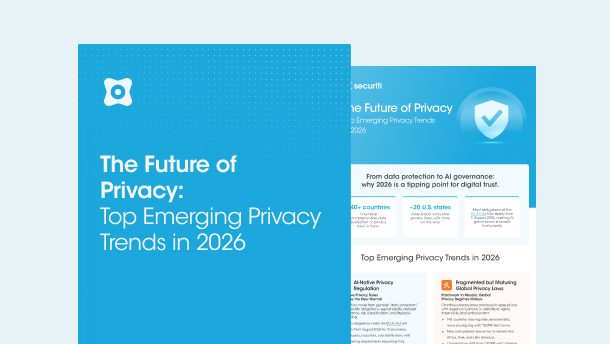Personally identifiable information (PII) is defined by the US Department of Homeland Security as information that can uniquely identify an individual, such as an employee, patient, customer, or donor. In addition to PII, “Sensitive PII” is data that, if compromised, could result in greater risk to the individual, this may include an individual’s government defined number (such as US Social Security Number) number, financial information, sex, sexuality etc.
There are now hundreds of laws and regulations covering the collection, use, sharing, deletion and security controls for PII and sensitive PII and new ones are being enacted every month (for example The Kingdom of Saudi Arabia’s new laws comes into force in March 2022). Consumers are better informed than ever about the value of their data, the problems if it is misused or lost and regulators are investigating companies who have built their business on data collection, so organizations need to be sure that they are using data legally within this maze of regulations.
Whether it is for data protection, governance, or regulatory compliance, everything starts with knowing what type of data classifies as sensitive, where it resides, what its security posture is, and what judicial laws apply to it. There is where the need for an effective PII data discovery tool arises.
Importance of PII Data Discovery in a Dynamic Environment
Arm Treasure Data reports that 47% of marketers agree to the fact that data is siloed, and thus, difficult to access. Take, for instance, in a marketing campaign, the sales team uses a lead’s data to turn them into paying customers, and the finance team uses the same data to process one-time or recurring payments. Then, the same data is used by the product marketing team to send retention emails to the customers.
In the previous example, every department is processing the data differently, potentially needing access to different PII. The finance team needs access to the credit card data to process the payment, while the email marketing team uses customers’ names and email addresses to send them emails. Together with the customer’s country (to set the correct pricing) and language to make sure the emails are read, sales needs to know their full address and customer success need full product version details. However, none of these teams need to know everything. For this reason (and others), the same data may be replicated throughout the organization in different siloed databases making control, updates and therefore data accuracy a very difficult task.
Apart from data silos, the advent of hyper-scale cloud computing environments like Snowflake has given rise to seamless collaboration in the cloud. Most organization’s employees are free to access the cloud, run petabyte-scale queries from different locations, and thus, produce more data in the process. To put this in perspective, it is forecasted that the cloud environment will have more than 100 zettabytes of data by 2025.
This cloud data is then scattered across multiple data lakes, databases, apps, and even personal computers. This creates a lack of visibility into the security posture of the data or its compliance status, putting it at serious risk of security breaches or compliance failure.
Data governance, security, and compliance require seamless visibility and insights into PII. A sensitive data discovery tool delivers just that, aiding CISOs and DPOs in having complete visibility into the data, and its security and compliance status.
Best PII Data Discovery Practices
An organization’s data discovery process should consider the following data discovery best practices to identify, classify, and analyze PII.
- Discover shadow assets and native assets: Data discovery starts with identifying where the data resides. The data may reside in the shadow as well as native data assets. Native data assets may include data warehouses, data lakes, or databases across on-premise or multi-cloud environments. Shadow data assets can be unregistered systems that were added to the cloud but not documented in the CMDB.
- Catalog data assets metadata: Next step is to detect and catalog the metadata across shadow and native assets. The metadata may further be classified into business, technical, and security metadata, such as vendor information, port information, version, encryption status, etc.
- Classify unstructured and structured data: Detect unstructured and structured sensitive data that resides in scattered doc types and across different tables and rows in a data store, respectively. Appropriate classification later allows teams to effectively map the data to its owners and assess its security and privacy posture.
- Use policy-based labeling: Policy-based labeling classifies data into different categories, purposes, or content profiles, such as Business, Financial, Academic, etc.
- Define security-based labeling: In security-based labeling, sensitivity classification is applied to data, such as emails, documents, etc. The data is then protected according to the sensitivity level of the data which is categorized into, Confidential, General, Public, and Secret.
- Apply privacy-based labeling: In this type of classification, the data is tagged based on the privacy risks it carries. This data gives insights into the privacy concerns related to any data, such as whether it needs to comply with Article 30 under GDPR. Is it needed for any data subject request (DSR) fulfillment?
Traits of an Effective PII Data Discovery Solution
In a petabyte-scale environment, it is not humanly possible to dig through millions of bytes of disparate data, classify it, or analyze it. There’s a need for a smart data discovery tool that can take petabytes of raw data, classify it, refine it, and help security and privacy teams ensure better security, governance, and compliance.
An effective PII data discovery tool ought to have the following important characteristics that can help organizations gain better visibility and control.
- It should be AI-driven for better speed and efficiency.
- It should have native connectors to achieve seamless integration with different data assets.
- It should also have native CMDB integration and regular scanning capability to help system administrators keep an updated catalog of data assets.
- It should have an extensive detection engine, containing built-in and custom data elements for effective data discovery.
- It should use artificial intelligence, machine learning, and natural language for contextual analysis to discover data in structured and unstructured systems accurately.
- It should allow multiple data scanning for faster data discovery.
- It should support a multitude of formats to effectively discover and tag every byte of data.
- It should use policy-based, security-based, and privacy-based predefined templates for data labeling.
How Securiti’s AI-Driven Robotic Sensitive Data Discovery Tool Can Help
With data-driven enterprises operating in hyper-scale environments, an AI-driven deep sensitive data discovery solution can give them an edge. Securiti delivers an AI-powered sensitive data discovery solution that can help organizations automate the discovery and classification of data assets and sensitive information across on-premise, native, non-native, and multi-cloud networks.
Take a look at the most prominent features of our Sensitive Data Discovery tool:
- 200+ native connectors that seamlessly integrate with a multitude of data assets.
- Built-in and custom data elements for the deep discovery of sensitive data.
- AI/ML techniques that can effectively detect sensitive data in tables, columns, or document categories.
- Support Big Data formats, such as AVRO.
- Support multiple data discovery scans for faster scanning at a granular level.
- Pre-defined templates for policy-based labeling.
- Built-in Microsoft Information Protection (MIP) integration for detecting and tagging security-based labels.
Watch a demo to learn how Securiti’s Data Discovery tool can help you detect disparate data and derive meaningful insights.












































